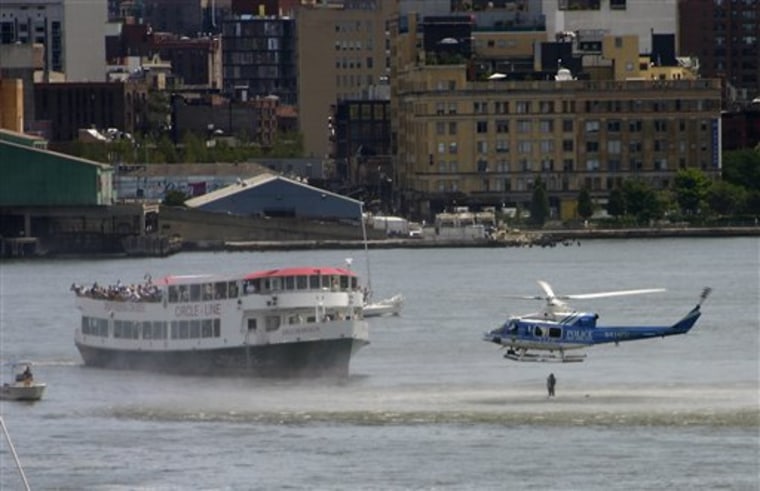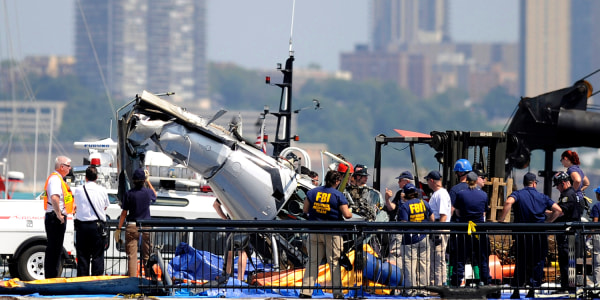New York police say the last two bodies have been pulled from the wreckage of a collision between a small plane and a sightseeing helicopter over the Hudson River.
Spokesman Paul Browne said Tuesday investigators believe the bodies were those of the plane pilot and a passenger. They were among nine people killed in Saturday's crash.
The bodies were found as recovery workers salvaged their first piece of the plane. It was found Monday in about 60 feet of water.
The Piper airplane collided with the helicopter in the congested airspace between New Jersey and Manhattan.
The recovery effort was deliberate, as divers contended with tricky currents, low visibility and the need to carefully lift the wreckage so potential clues weren't disturbed.
Two members of the New York Police Department dive team went into the water about 3:20 p.m. Divers carried a large flat strap, 6 to 8 inches wide, with a large metal shackle on one end, while a crew aboard a second dive boat fed out two cables. Within a few minutes, an Army Corps of Engineers boat equipped with a large crane moved into position near the site of the wreckage.
Rescuers struggle to lift wreckage
Almost two hours later, the partial wreckage was painstakingly hoisted to the surface.
The Piper airplane that collided with the helicopter in the congested airspace between New Jersey and Manhattan was heavily damaged and waterlogged, making recovery delicate, federal safety officials said.
"We're going to be examining the wreckage, looking at the control surfaces, looking for any missing parts, and we may need to do more searching and recovery for any parts that are missing," said Deborah Hersman, chairwoman of the National Transportation Safety Board.
Investigators will check to see whether all the controls were working and if there was power from the engine when the aircraft collided, Hersman said.
"Obviously it's in very deep water," she said. "It's heavy, it's waterlogged and when they pull it out they want to make sure all the aircraft parts remain attached."
Police divers placed chains on the front of the plane — resting on its side at the river bottom — near the engine and near the tail Monday to prepare to lift it.
Also on the scene was the 30-ton Moritz, an Army Corps vessel that has a small crane. The ship, normally used to conduct hydrographic surveys, helped search for a missing engine after U.S. Airways Flight 1549 made an emergency landing in the Hudson River in January.
Investigators also planned to conduct interviews with controllers at Newark Liberty International Airport to try to piece together the flight route of the small plane into the Hudson River corridor, where it smashed into the helicopter at 1,100 feet Saturday.
A worry-free radio exchange
Air traffic control transcripts described Monday indicate a worry-free exchange between controllers at Teterboro, in New Jersey, and the plane's pilot, Steven Altman, who was told he could pick his flight path toward Ocean City, where he was flying after picking up his brother Daniel Altman and teenage nephew Douglas Altman.
Slideshow 13 photos
Helicopter, small plane collide over Hudson River
The air traffic controller at Teterboro Airport gave him two choices: Head down the river, or take a southwest tack.
When a Teterboro controller asked the pilot if he wanted to go down the river or head southwest, he responded by saying: "Either."
"Let me know," the controller said.
"OK, tell you what," Altman replied, "I'll take down the river."
Hersman said air traffic controllers at Teterboro at some point told Altman to switch radio frequencies so Newark controllers could communicate with him, but Newark never made contact, she said.
All seven of the victims whose bodies were recovered have been positively identified through dental records and fingerprints, the New York medical examiner's office said. Autopsies found they died from blunt-impact injuries.
The collision at around noon on a sunny Saturday occurred in a congested flyway popular with sightseers. Hersman said an eight-day NTSB survey of the river corridor before the collision had counted about 225 aircraft flying within a 3-mile radius of the collision site each day.
Many of these tour craft fly below 1,100 feet, where pilots are largely free to choose their own routes, radioing their positions periodically but not communicating regularly with air traffic controllers.
Agency investigation will take months
The NTSB has issued at least 14 safety recommendations — 12 for collision avoidance — for flight in congested areas across the country, and more than 50 for the operation of air tours, Hersman said.
The NTSB has declined to speculate about the cause of the crash. The agency's investigation is expected to take months.
The helicopter had just taken off from Manhattan's West Side for a 12-minute tour. Witnesses said the small plane approached the helicopter from behind and clipped it with a wing. Hersman said the helicopter was gaining altitude when the two aircraft collided.
Both aircraft split and fell into the river, scattering debris and sending weekenders enjoying the beautiful day on the New Jersey side of the river running for cover.

